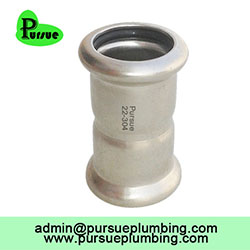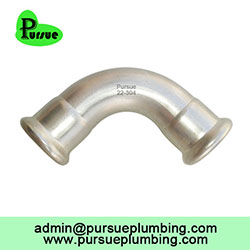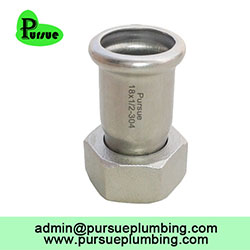
Equal coupling high quality sa
PURSUE is manufacturer of stainless steel press fitting, more than 10 years expe...

Reducing coupling high quality
PURSUE is manufacturer of press fitting, more than 10 years experience, high qua...

high quality plumbing M profil
PURSUE is manufacturer of press fitting elbow, more than 10 years experience, hi...

Good price china stainless ste
PURSUE is manufacturer of stainless steel tee press fitting, more than 10 years ...

For water gas oil stainless st
PURSUE is manufacturer of stainless steel pipe fitting union, more than 10 years...

press fit plumbing pipe connec
PURSUE is manufacturer of stainless steel male press fittings, more than 10 year...

female threaded pipe bend chin
PURSUE is manufacturer of stainless steel press fit 90 elbow fitting, more than ...

China 15 to 108 mm stainless s
PURSUE is manufacturer of stainless steel male press elbow, more than 10 years e...

2 piece ball valve china suppl
Pursue plumbing supply 2 piece ball valve, 2 piece ball valve china supplier, 2 ...

stainless steel gate valve chi
stainless steel gate valve china supplier, stainless steel gate valve, stainless...

stainless steel swing check va
PURSUE supply stainless steel swing check valve, we are swing check valve china ...

stainless steel 2 piece flange
PUSUE is 2 piece flange ball valve supplier, we supply stainless steel 2 piece f...
As a Press fitting manufacturer in china, PURSUE has markets in various countries of the world, Pursue Produce full range of stainless steel press fittings. Regardless of the type of product, you are searching for; you can be assertive to the fact that you will find a complete range of assortment and sizes of all grade types.
Our considerable inventory contains not only standard industry sizes but also the hard sizes which are difficult to find and that only the leading Stainless steel press fitting manufacturer. In addition to our complete range of Stainless steel press fitting, we provide our customers with a vast array of services to adapt and customize up to their specifications and requirements.
Our services are premium, and we have maintained standards as per the needs and requirements of the existing market. We feel assured that we can provide quality services to our clients all over the world. Our existing program of investing in technology has created an impact and made us a world class manufacturer with a quality workforce and management dedicated to preserving our status at the front of the Stainless steel ball valve manufacturer.
We are a market leader and leading Stainless steel ball valve manufacturer and our desire to provide the best Stainless steel ball valve with quality services at convenient rates. In order to achieve this objective, we work closely with our customers ensuring that our services and products assist them in attaining a competitive edge in comparison to their rivals in the market.
Contact: Steven
Phone: 0086-177-2816-0337
Tel: 0086-177-2816-0337
Email: admin@pursueplumbing.com
Add: NO. 12 Shi Road, HuangBian, ShiQiao, PanYu, GuangZhou, Guangdong, China